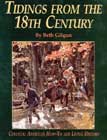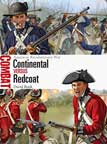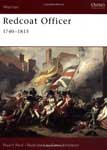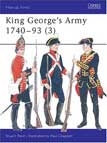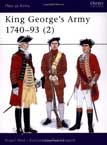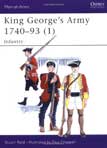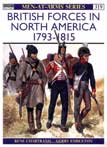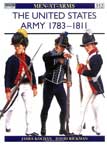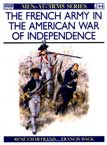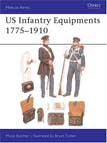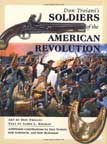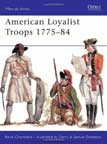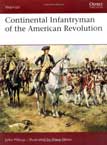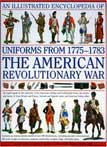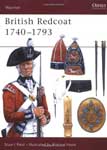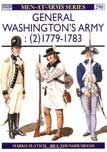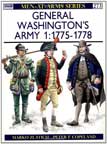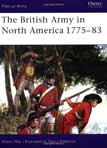

Beth Gilgun brings the mid to late 1700s to life with her entertaining and informative "letters" to a friend on the frontier. Great for reenactors, teachers, historic interpreters, and theatrical costumers. As an accomplished seamstress and goodwife, Gilgun shares with her "friend" information on clothing for men, women and children, as well as other topics of daily life in Colonial America. Included are clear, concise instructions for constructing reproduction 18th century garments, from choosing fabric to finishing. Her chatty letters include news about current events and the latest goods available on the East Coast.
*I met Beth Gilgun at a RevWar event once. I found her to be as neat in person as she seems in her books.
In June 1775 the Continental Congress, leading the American rebellion against the British Crown, created the Continental Army to serve in the line of battle alongside militia and "Provincial" units. Although supply problems, issues with discipline, and poor training hampered the Continentals' effectiveness in combat, they were able to inflict a decisive defeat on the British at Yorktown. In contrast, the backbone of the British forces in North America were long-service regular infantrymen, serving for the most part in single-battalion regiments. They had earned a formidable reputation on Europe's battlefields during the Seven Years' War, but in fighting the French in North America during that conflict had already learned a great deal about the very different fighting conditions prevalent in the New World.
In a host of encounters ranging from skirmishes to decisive pitched battles, the infantrymen of both sides would be tested to the limit, with supply problems, hostile terrain, and poor weather all adding to the horrors of close-quarter combat. Featuring full-color artwork, specially drawn maps, and archive illustrations, this engaging study offers key insights into the tactics, leadership, combat performance, and subsequent reputations of six representative Continental and Redcoat infantry regiments pitched into three pivotal actions that shaped the outcome of the American Revolutionary War.
The commissioned officer ranks in the British Army from 1740-1815 were almost entirely composed of the affluent and educated - the sons of the landed gentry, the wealthy, and other professional people. This title looks at the enlistment, training, daily life and combat experiences of the typical British officer in the crucial periods of the North American conflicts, the American Revolution, and the Napoleonic Wars. It compliments the author's previous treatments in Warrior 19 British Redcoat 1740-93 and Warrior 20 British Redcoat (2) 1793-1815, which deal exclusively with the common infantryman, and balances these discussions through a look at the 'fellows in silk stockings'. Particular emphasis is placed on the experiences and activities in North America in the late 18th century.
The 18th century was marked by a steady growth in central control of the British Army and a corresponding decrease in the influence enjoyed by individual commanding officers. The most obvious sign of this process was the increasing uniformity of the clothing issued each year to the soldiers. Nevertheless, as far as those who devised the Clothing Regulations were concerned, it was a constant, and invariably quite uphill struggle to enforce compliance. This companion volume to Men-at-Arms 285 and Men-at-Arms 289 examines the organization and uniforms of King George’s cavalry and artillery together with those of the Board of Ordnance.
The 18th century was marked by a steady growth in central control of the British Army and a corresponding decrease in the influence enjoyed by individual commanding officers. The most obvious sign of this process was the increasing uniformity of the clothing issued each year to the soldiers. Nevertheless, as far as those who devised the Clothing Regulations were concerned, it was a constant, and invariably quite uphill struggle to enforce compliance. This companion volume to Men-at-Arms 285 takes a further look at the infantry uniforms of the mid-18th century British Army, also covering the various auxiliary infantry formations, such as the Militia, Volunteers, Marines and the troops of the East India Company.
To most contemporary politicians the 18th century British Army was no more than an unwelcome necessity in wartime and an unjustifiable extravagance in peacetime. Nevertheless, the overall impression which is to be gained from a close study of the Army's own records, and from the surviving letters, diaries and memoirs, is that the British Army of the 18th century was very little different in character or in spirit from today's British Army. It was, above all, a force which was led, not driven, into battle. This book looks at the uniforms and organisation of the infantry of King George's Army as well as its participation in various conflicts, such as the War of the Austrian Succession (1740-1748) and the Seven Years' War (1756-1763).
The end of the American Revolution in 1783 confirmed the independence of the republic of the United States of America from Great Britain. Britain, however, still managed to make its presence felt in North America. Britain's Orders in Council concerning trade were a major irritant which, added to other issues including the sale of Louisiana and the impressment of American soldiers by the Royal Navy, finally caused the United States to declare war on 19 June 1812. This volume examines in detail the organisation, tactics and equipment of the British forces between 1793 and 1815.
When the Revolutionary War (1775-1783) ended Washington's victorious Continental Army was disbanded. The infant United States had very mixed feelings about standing armies; but years of Indian-fighting on the frontier emphasised the need for a force larger than Josiah Harmar's original 700-man 1st American Regiment. In the event Secretary Hamilton's far-sighted reforms, which produced 'Wayne's Legion' in the early 1790s, were to be short-lived, and it took later threats of international war to stimulate the eventual expansion of the young US Army. James Kochan's meticulously researched study of a dramatic and confused period in American military history - the years of St Clair's disaster, 'Mad Anthony' Wayne's victory at Fallen Timbers, and Harrison's at Tippecanoe - is illustrated with many rare and important paintings and drawings.
The French forces that fought during the American War of Independence (1775-1783) were, to a large extent, a product of the disasters of the Seven Years' War (1756-1763). During that war the fleet had been swept off the oceans, and nearly all colonies had been lost. Sweeping reforms were demanded. From the end of 1762 a series of royal orders dictated by common sense and good planning were signed by the king, and a vast reorganisation was started, ensuring that the army that fought in the American War presented a very different, altogether more formidable threat to her foes.
The development of US Army infantry equipment has been a story of trial and error, of adopting new designs to meet new problems. It was not until 1910 that a whole system of equipment, including everything from the waist belts to the canteens to the cartridge-carriers to the haversack, was officially adopted. Prior to that, each piece of equipment was designed to meet a specific need, without any consideration of anything else the soldier had to carry. Packed with photographs and illustrations, this book explores the history of US Infantry equipments from 1775 to 1910, covering everything from blankets to bayonets.
- Vibrant color paintings illustrate soldiers and battles of the war
-
Color photos of seldom-seen period artifacts such as uniforms, weapons, and other equipment
In this collection, renowned artist Don Troiani teams up with leading artifact historian James L. Kochan to present the American Revolution as it has existed only in our imaginations: in living color.
From Bunker Hill to Yorktown, from Washington to Cornwallis, from the Minute Men to the Black Watch, these pages are packed with scenes of grand action and great characters, recreated in the vivid blues and reds that defined the Revolutionary era. Troiani's depictions of these legendary fife-and-drum soldiers are based on firsthand accounts and, wherever possible, surviving artifacts. Scores of color photographs of these objects--many of them from private collections and seen here for the very first time--accompany the paintings. Items range from muskets and beautifully ornate swords to more unique pieces such as badges with unit insignia or patriotic slogans and Baron von Steuben's liquor chest.
More than just a glimpse into a world long past, this is the closest the modern reader can get to experiencing the Revolutionary War firsthand.
To mark the 450th book in the Men-at-Arms series we return to the subject of the very first book in the series, which was published nearly 35 years ago. Author of 27 other Men-at-Arms titles René Chartrand uses newly discovered material to offer a more modern analysis of the American Provincial Corps in this book, American Loyalist Troops. Packed with new photographs, completely new and up-to-date text and illustrations from Gerry Embleton (the much-loved illustrator of over 60 Osprey titles) this book examines the history of the American volunteers who fought on the side of King George in the American Revolutionary War (1775-1783).
In total something between 30,000 and 50,000 of these "Tories" served in dozens of units, on all fronts from Canada to Florida, and many regiments distinguished themselves in battle. After the final British defeat the survivors and their families withdrew, many into Canada, where they continued to provide a loyal militia to defend the Crown territory. This book will provide updated and comprehensive information on unit identities, commanders, strengths, areas of enlistment, combat record, tactics, uniforms and equipment.
America raised three distinct forces to win its revolution: untrained, short-service militiamen; state troops; and the regular Continentals. The latter were the backbone of the army, providing a disciplined and effective fighting force. Some infantrymen served with Arnold's Lake Champlain fleet as marines, while others fought conventionally in sieges and field battles. This book takes a close look at the Continental infantryman of the period examining all facets of their daily life including recruitment, training, service conditions and combat experiences. Many armies have saved their nation: the Continentals helped build theirs.
A definitive analysis of the weapons, equipment, deployment, tactics and motivation of these national forces, as well as fascinating detail of day-to-day life for the soldiers that fought the battles.
This is the first book since John Mollo's Uniforms of the American Revolution from 1976 to feature a well-illustrated guide to ALL the forces of the War for Independence.
This book has really well-done color images of many of the aspects of the war. While other books have presented examples of Continental and British soldiers, other combatants such as Loyalist, German, French, Native American and Spanish forces were often underrepresented or absolutely ignored. Fortunately, this text includes extensive color illustrations of the uniforms of understudied aspects of this conflict. Irish and Highland troops are nicely represented. There is a fine presentation of the Naval and Marine forces of the participating countries which have often been ignored in other sources. Controversies regarding the uniforms of the American Revolution abound.
During this period, the British army earned itself a formidable reputation as a fighting force. However, due to its role as a police force at home, and demonisation by American propaganda during the American Revolution (1763-1776), the army was viewed as little removed from a penal institution run by aristocratic dilettantes. This view, still held by many today, is challenged by Stuart Reid, who paints a picture of an increasingly professional force. This was an important time of change and improvement for the British Army, and British Redcoat 1740-1793 fully brings this out in its comprehensive examination of the lives, conditions and experiences of the late 18th-century infantryman
For the early years of the American War of Independence (1775-1783), George Washington’s troops were clothed in a variety of uniforms from various sources. With the receipt in late 1778 of over 25,000 uniforms imported from France, much of the Continental army was uniformly clothed in blue or brown coats faced with red. This study by Marko Zlatich focuses on the systems used by state and Continental authorities to procure clothing materials from this point onwards, the quantities they obtained and the specifications of the uniforms themselves. Eight colour plates by the talented Bill Younghusband and a plethora of black and white photographs and illustrations usefully support the author’s detailed text.
During the period 1775-78 of the American Revolutionary War, General Washington commanded three separate armies: the New England Army of 1775; the one-year army of the United Colonies, renamed Army of the United States in July 1776; and the forces established by the Continental Congress to serve for three years from January 1777, or for the duration. In this, the first of two studies by Marko Zlatich (Men-at Arms 290 continues the treatment, covering the period from 1779-83), the systems used by state and Continental authorities to procure clothing materials, the quantities they obtained and the specifications of the uniforms themselves are all examined in detail.
For sheer guts, the Redcoats' behaviour at Bunker Hill, Saratoga and other bloody encounters has rarely been surpassed. The Americans won, but only just, and then thanks to foreign intervention and a small number of dedicated and valiant patriots who were continually let down by their own people. Robin May's splendid work looks at the British Army that fought in the American Revolution from 1775 to1783. It details the soldiers who faced the difficulties of campaigning in America along with the gross inefficiency and corruption at home which, along with their generals' often blundering conduct, were as deadly enemies as the Americans.
Pope Coelestinus V ends term
Council of Trent (19th ecumenical council) opens
Sweden / Denmark signs Peace of Stettin
Spanish army beats Geuzen fleet under Admiral Lumey
Sir Francis Drake sets sail from England to go around world
Emperor Ferdinand II delegates 1st anti-Reformation decree
New Zealand discovered by Dutch navigator Abel Tasman
Jean Racines "Britannicus, " premieres in Paris
England and Russia sign trade agreement
Willem KH Friso tests his mothers potatoes
1st music store in America opens (Philadelphia)
Dartmouth College in New Hampshire received its charter
1st incident of Revolution-400 attack Ft William and Mary, New Hampshire
Patent for a dry dock issued to John Adamson, Boston
Gioacchino Rossini arrives in London
"A Christmas Carol" by Charles Dickens published, 6,000 copies sold
Battle of Alleghany Summit, West Virginia
Battle of Ft McAllister, Georgia
1st federal fish hatching steamer lauched (Wilmington Delaware)
Belgium rules on women / child labor law
1st complete execution of Gustav Mahlers 2nd Symphony
Battle at Nooitgedacht: generals The la Rey / Smuts beat Britten
Test debut of S F Barnes vs. Aust SCG, took 5-65 in 1st innings
Italo Marcioni patents ice cream cone (NJ)
Wright Bros make 1st flight at Kittyhawk
George Gunn scores 119 on Test debut vs. Australia SCG
German Emperor Wilhelm II visits Amsterdam
Mona Lisa stolen in August 1911 returned to Louvre
Avalanche kills 10,000 Austrian and Italian troops in 24 hours in Tyrol
Esme Stuart Lennox Robinsons premieres in Dublin
French Chief of Staff Joffre replaced by Nivelle
US army of occupation crosses Rhine, enters Germany
Wilson, becomes 1st to make a foreign visit as President (France)
Ross and Smith land in Australia from a flight from London
League of nations establishes International Court of Justice in The Hague
Netherland breaks contact with kingdom of Serbia, Croatia and Slavia
KOA-AM in Denver CO begins radio transmissions
Clip-on tie designed
Theodore Steeg forms French government
Mark Hellinger Theater (Warner Bros) opens at 237 W 51st St, New York City
Final Boston Redskin NFL game, lose to Packers 21-6, move to Washington DC
Green Bay Packers win NFL championship
Battle at La Plata - 3 British cruisers vs. German Graf Spee
German occupiers forbid National Front and Netherlands Union
Lawine battlers destroy Haaraz, Peru; about 3,000 die
U-81 torpedoes British aircraft carrier Ark Royal
Seyss-Inquart allows Dutch Nazi Anton Mussert to call himself Leader
Washington Redskins defeat Chicago Bears 14-6, to win NFL title
150 US Marauders bomb Schiphol
Japanese kamikaze crashes into US cruiser Nashville, kills 138
"Caribbean Carnival" closes at International NYC after 11 performances
Maine Turnpike opens to traffic
AL votes down proposal to revive spitball
James Dean begins his career with an appearance in a Pepsi commercial
Future British Prime Minister Margaret Roberts Thatcher marries Denis Thatcher
KOAM TV channel 7 in Pittsburg-Joplin, KS (CBS) begins broadcasting
Dodgers trade Jackie Robinson to Giants for pitcher Dick Littlefield and $35,000 Robinson retires
Archbishop Makarios elected 1st President of Cyprus
Italy beats US in Davis cup (1st time in 24 years US not in finals)
Laos General Fumi Nosavang occupies Vientiane
Beatles sign a formal agreement to be managed by Brian Epstein
Gideon Hausner in Jerusalem demands death penalty for Adolf Eichmann
Relay 1 communication satellite launched
Capital records signs right of 1st refusal agreement with Beatles
Shirley Englehorn and Sam Snead wins Haig and Haig Mixed Foursome Golf
1st battle for Bijlmer flats Amsterdam
1st US bombing of Hanoi
Test debut of Clive Lloyd, vs. India Bombay, 82 and 78
United Soccer Association and National Pro Soccer League merge into NASL
Unsuccessful coup against Greek King Constantine II
Playland at Beach reopens
President Da Costa e Silva disbands parliament / grabs power
Greg Chappell scores 108 on Test debut vs. England at the WACA
John Sinclair (sentence: 10 yrs, sold 2 marijuana joints) is freed
MPLA / FNLA accord about combat against Portuguese Libya
World Football League grants 1st franchise (Detroit)
Malta becomes a Republic
1st time Saturday Night Live uses a time delay (Richard Pryor hosts)
Australian Conservatives and Liberals win parliamentary election
Jane Blalock wins LPGA 14 Colgate Triple Crown Golf Tournament
Roy Fredericks hits 169 vs. Aust at WACA, hundred in 71 balls
Golden Gate Bridge District starts ferry service to Larkspur
Longest non-stop passenger airflight (Sydney to SF 13h14m)
14 University of Evansville basketball players die in plane crash
Susan B Anthony dollar, 1st US coin to honor a woman, issued
"Oklahoma!" opens at Palace Theater NYC for 301 performances
Strikes against price increases in Gdansk Poland
"Perfectly Frank" closes at Helen Hayes Theater NYC after 16 performances
70th Davis Cup: USA beats Argentina in Cincinnati (3-1)
Polish government declares martial law, arrests Solidarity activists
71st Australian Mens Tennis: Johan Kriek beats Steve Denton (63 63 62)
Earthquake hits Northern Yemen; 2,000 die
9,655 see highest-scoring NBA game: Detroit 186, Denver 184 (3 OT)
British Airways incorporates
KYA-AM in San Francisco CA changes call letters to KOIT
Artificial heart recipient William Schroeder suffers 1st stroke
Test debut of Merv Hughes, Geoff Marsh and Bruce Reid (vs. India)
Belgium Christian Democrats (CVP) loses parliamentary election
Browns set club record for most points scored in a quarter, 28
3 men end 29-hr all-466-station subway ride in New York City
Arafat addresses UN in Geneva
Walter Davis (Denver) ends NBA free throw streak of 53 games
"Peter Pan" opens at Lunt-Fontanne Theater NYC for 45 performances
Heavy earthquake strikes Sicily, 18 die
President De Klerk of South Africa meets with Mandela to talk of end of apartheid
Both Koreas sign an accord calling for reconcilliation
New York assembly speaker Mel Miller is convicted of federal mail fraud
Ricky Pierce (Seattle) ends NBA free throw streak of 75 games
"Show Off" closes at Criterion Theater NYC after 45 performances
Dawn Coe-Jone wins Pizza-La LPGA Match Play Golf Championship
FCC fines Infinity Broadcasting $600,000
Dow Jones hits record 3764.43
Fire in textile factory in Fuzjou China, 60 killed
Space shuttle STS-61 (Endeavour 5), lands
American Eagle commuter plane crashes in NC, killing 15
Christopher Reeves released from physical rehab center
US Federal Court votes that Cable companies must carry local stations
Free agent Roger Clemens signs with Toronto Blue Jays
63rd Heisman Trophy Award: Charles Woodson, Michigan (CB)
